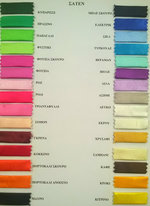The world’s first thesaurus of colour shades: What kind of yellow is an egg yolk? (Independent)
[...] Colour in fiction is something every creative writing student has wrestled with in the hope of finding new and evocative ways to describe stuff. Curiously, though, it wasn't something that the first writers of epics worried overly much about… mainly because they didn't seem to have many colours to go at.
Unlike prime minister William Gladstone. When he was merely MP for the University of Oxford constituency, he began to write a book about Homer – and in his researches noticed an intriguing lack of colour descriptions, especially for blue. Pondering on the “wine-dark” epithet so frequently attached to the sea in The Odyssey, Gladstone was puzzled that the description made no allusion to blue or green – as might be expected – and decided to count the mentions of colours in the Greek epic. (Obviously, business around the constituency wasn't too taxing.) What he discovered was that, while black and white were mentioned a fair few times, red only got 15 or so name-checks and blue none at all. Gladstone's work intrigued the German philosopher Lazarus Geiger who decided to apply it to other forms of ancient literature – the Indian Vedas, the Aryan Avesta, the Icelandic sagas – and found that blue in particular was absent, leading him to determine that humanity's notion and observation of colour had evolved considerably over the millennia. [...]
[...] Colour in fiction is something every creative writing student has wrestled with in the hope of finding new and evocative ways to describe stuff. Curiously, though, it wasn't something that the first writers of epics worried overly much about… mainly because they didn't seem to have many colours to go at.
Unlike prime minister William Gladstone. When he was merely MP for the University of Oxford constituency, he began to write a book about Homer – and in his researches noticed an intriguing lack of colour descriptions, especially for blue. Pondering on the “wine-dark” epithet so frequently attached to the sea in The Odyssey, Gladstone was puzzled that the description made no allusion to blue or green – as might be expected – and decided to count the mentions of colours in the Greek epic. (Obviously, business around the constituency wasn't too taxing.) What he discovered was that, while black and white were mentioned a fair few times, red only got 15 or so name-checks and blue none at all. Gladstone's work intrigued the German philosopher Lazarus Geiger who decided to apply it to other forms of ancient literature – the Indian Vedas, the Aryan Avesta, the Icelandic sagas – and found that blue in particular was absent, leading him to determine that humanity's notion and observation of colour had evolved considerably over the millennia. [...]

